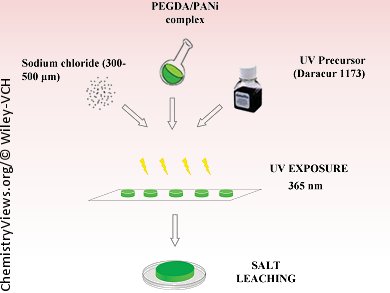Conducting polymers are linear or branched organic chains that contain conjugated double bonds or aromatic rings and, hence, have the ability to conduct electricity. Their incorporation into bioactive scaffolds is of interest in tissue engineering as it could help electrically stimulate cells and promote activities needed for nerve regeneration, e.g., neurite growth.
Vincenzo Guarino, Institute of Composite and Biomedical Materials, Naples, Italy, and colleagues have found a simple method of making a hybrid scaffold that includes a conducting polymer, polyaniline (PANi), and a macroporous hydrogel, polyethyleneglycol diacrylate (PEGDA). The team used in situ precipitation of PANi in a PEGDA solution, followed by cross-linking through UV irradiation. Finally, leaching of NaCl resulted in a porous architecture, with pores from 136 μm to 158 μm in size.
The team demonstrated that the hybrid PANi/PEGDA scaffold combined the electrical properties of PANi with the high diffusivity of small molecules and the high degree of hydration associated with hydrogels. This combination of properties makes PANi/PEGDA hybrid scaffolds ideal candidates for further investigation for in vitro and in vivo nerve regeneration.
- Conductive PANi/PEGDA Macroporous Hydrogels For Nerve Regeneration,
Vincenzo Guarino, Marco Antonio Alvarez-Perez, Anna Borriello, Teresa Napolitano, Luigi Ambrosio,
Adv. Health. Mat. 2012.
DOI: 10.1002/adhm.201200152




